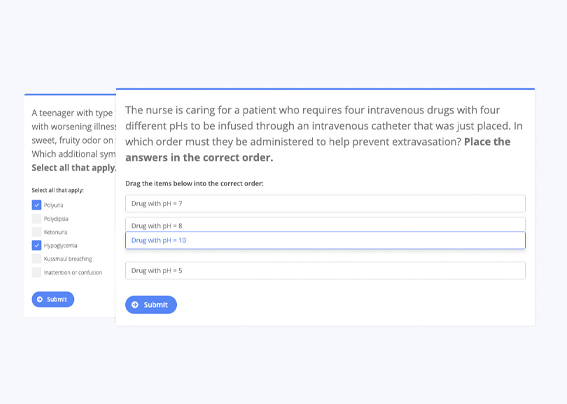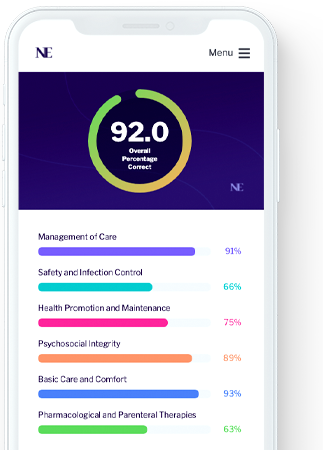7 Types of Alternate-Format NCLEX Questions (and How to Dissect Them) – Part One
The NCLEX is unique. Not only do you have to contend with standard multiple-choice questions, the test also features a smattering of alternate-format questions that may contain diagrams, charts, audio, or even multiple correct answers! The good news is there are only a few types of alternate-format questions, so you can prepare to tackle each kind. But first, it helps to know a little bit about the NCLEX format.
How Does the NCLEX Work?
The NCLEX is a computerized test administered to all prospective nurses seeking licensure in the United States. It is developed and administered by the National Council of State Boards of Nursing (NCSBN). The test uses a special kind of test algorithm, called Computerized Adaptive Testing (CAT), to evaluate each candidate’s knowledge and critical thinking skills. CAT is different from other testing methods because it aims to measure one’s true ability. It accomplishes this by altering the level of difficulty for each question based on your previous answers.
For example, if you get a question correct, the computer will present you with a subsequent question it thinks you have a 50% chance of getting right. This ensures that the question will be neither too hard nor too easy—in fact, the level of difficulty is just right. As your number of correct answers increases, the level of difficulty gradually increases. If you get a question wrong, the test will present you with a slightly easier question. Over time, the computer develops a precise measurement of each test candidate’s true nursing ability.
The NCLEX test will end when the computer is 95% certain you have either surpassed or fallen short of the passing standard. Test-takers will need to answer anywhere from 85 to 150 questions during the exam. You cannot skip any questions. Every test is individualized, so you won’t answer the same questions as the person sitting next to you. While you might assume that candidates who receive only 85 questions either did really well or really poorly, it simply means the computer was able to accurately assess true ability with fewer questions.
The test will also end if a candidate answers the maximum number of questions or runs out of time (there is a five-hour time limit). Neither of these outcomes guarantees a failing grade. If you answer all 150 questions, the test will simply take a final measure of your ability. If the final score is above the passing standard, you pass! If not—well, you know what happens. On the other hand, if your time expires, the computer will evaluate your score based on your final 60 questions. If every question is marked above the passing standard, you pass. If even a single question falls below the line, you fail. Luckily, five hours is a long time, and it’s unlikely that your clock will run out before the test gets an accurate assessment of your ability.
Every NCLEX test consists of a combination of standard multiple-choice questions as well as special items called alternate-format questions. You are much more likely to pass the test if you are familiar with all types of NCLEX questions. In this series of articles, we will focus specifically on alternate-format questions.
What is an Alternate-Format Question?
At some point, the NCLEX test creators decided that multiple-choice questions were insufficient to test the knowledge of prospective nurses. Nursing requires top-notch critical thinking skills to make important decisions on the job, and alternate-format questions are simply another tool to test these skills. Since nurses must constantly assess priority, make drug calculations, and conduct physical assessments in real life, it made sense to add some questions that address these skills directly.
The NCLEX contains seven different types of alternate-format questions. These questions will appear randomly throughout the exam, and each question will contain the necessary instructions to help you choose the correct answer. For example, if the question has the potential for multiple answers, it will instruct you to select all that apply. If the question requires you to select a single option, it will tell you. Alternate-format questions are easy to spot because they look different from the typical multiple-choice questions.
There is no standard percentage of alternate-format questions on each individual test because every test is different. But you can expect these questions to make up around 10-20% of the exam. The official NCLEX test bank contains alternate-format questions of all difficulties (meaning you won’t only get the hard ones; expect some easy ones, too). Each question is scored as correct or incorrect. There is no partial credit.
The official list of alternate-format questions includes the following types of questions:
- Audio. Listen to an audio clip to answer the question.
- Chart/Exhibit. Read the available given chart/exhibit to find the information needed to answer the question.
- Graphic. Select the appropriate graphic to answer the question.
- Hot Spot. Identify an area on a photo or graphic.
- Multiple Response. Select more than one correct answer.
- Ordered Response. Prioritize or rank option choices accordingly.
- Fill-in-the-Blank. Usually reserved for calculations, the answer must be typed into the box provided. The question will state whether rounding is appropriate.
This post is the first of a five-part series explaining NCLEX alternate-format questions. The next four posts will dive into these seven types in more detail and provide example questions to help you adequately prepare for the exam. Read on to find out more about alternate-format questions and strategies to dissect each type of question.




